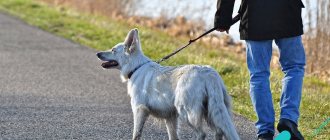In the Russian Federation, dog walking is regulated by a whole range of legal acts. Each region sets its own rules.
In 2021, a new law dated December 27, 2018 No. 498-FZ “On the Responsible Treatment of Animals” came into force, defining not only the general rules for keeping pets, but also the responsibility of their owners. What's new in the new law
The law is designed to regulate the treatment of animals for their protection, safety and rights, and to instill in people humane treatment of their smaller brothers.
In accordance with the new law, the owner of the animal must provide it with proper care and nutrition, timely veterinary care, vaccination, and take measures to prevent the appearance of unwanted offspring. You cannot treat pets cruelly or set them against people or other animals. Organizing fights involving animals is also prohibited.
If for some reason the owner is no longer able to keep the dog, he does not have the right to throw it out into the street. The law obliges the animal to be transferred to another owner, to a shelter or to a veterinary institution.
Current law in Russia
The territory of the Russian Federation is regulated not by one law, but by a system of regulatory legal acts. These include the adopted rules and amendments to them: Federal Law No. 498-FZ dated December 27, 2018 and amendments that entered into force on January 1, 2020. This government decision is based on previously adopted laws of the RSFSR. These regulations clearly indicate the rules for keeping pets and define the area intended for walking pets.
Walking a dog must be carried out according to the rules
Rules for walking dogs in public places
The law does not allow walking with dogs in park areas if there are no fenced areas designated for this purpose. In addition to this ban, walking in the green zone is regulated by internal acts and the Law on Dogs 2019, adopted with amendments coming into force on January 1, 2020.
Violating the law on walking with a pet may result in penalties. In special situations, in addition to administrative liability, criminal liability may be imposed. This type of punishment occurs if the animal has caused serious damage through inaction or with the permission of the owner.
For your information! Legislation and the Ministry of Internal Affairs have created a list of dangerous breeds of pets, according to which the rules for keeping animals in an apartment are even more stringent.
Walking animals must comply with the following rules:
- complete exclusion of the possibility of free or uncontrolled movement of the pet in areas that pose a danger to it. These include the elevator, road, courtyards and common areas of the apartment complex;
- organizing cleanup of the area from animal feces;
- walking only in places provided for this purpose by local government legislation;
- the pet on the list must be dressed in full gear.
An exception to the above rules is walking on private territory belonging to the pet owner. This area must be fenced. There is a text sign on the fence warning about the presence of a potentially unsafe dog. Rules for keeping dogs are a regulatory basis.
Federal Law of December 27, 2018 No. 498-FZ
RUSSIAN FEDERATION
THE FEDERAL LAW
On the responsible treatment of animals and on amendments to certain legislative acts of the Russian Federation
Adopted by the State Duma on December 19, 2021
Approved by the Federation Council on December 21, 2021
(As amended by federal laws dated December 27, 2019 No. 447-FZ, dated June 11, 2021 No. 170-FZ)
Chapter 1. General provisions
Article 1. Subject, goals of legal regulation and scope of application of this Federal Law
1. This Federal Law regulates relations in the field of treatment of animals in order to protect animals, as well as strengthen morality, observe the principles of humanity, ensure safety and other rights and legitimate interests of citizens when treating animals.
2. The provisions of this Federal Law do not apply to relations in the field of protection and use of wildlife, relations in the field of fishing and conservation of aquatic biological resources, relations in the field of aquaculture (fish farming), relations in the field of hunting and conservation of hunting resources, relations in the field of maintenance and use of farm animals and relations in the field of keeping and use of laboratory animals.
3. Charitable activities, voluntary (volunteer) activities in the field of treatment of animals are carried out in accordance with the legislation on charitable activities.
4. Relations arising during the transportation of animals are regulated by transport legislation, veterinary legislation of the Russian Federation and international treaties with the participation of the Russian Federation.
Article 2. Legal regulation of relations in the field of treatment of animals
Relations in the field of treatment of animals are regulated by this Federal Law, other federal laws and other regulatory legal acts of the Russian Federation, as well as laws and other regulatory legal acts of constituent entities of the Russian Federation adopted in accordance with them, and regulatory legal acts of local government bodies.
Article 3. Basic concepts used in this Federal Law
For the purposes of this Federal Law, the following basic concepts are used:
1) the owner of the animal (hereinafter also referred to as the owner) - an individual or legal entity to whom the animal belongs by right of ownership or other legal basis;
2) activities for the treatment of animals without owners - activities that include the capture of animals without owners, their maintenance (including treatment, vaccination, sterilization), return to their former habitats and other measures provided for by this Federal Law;
3) wild animals kept or used in captivity (hereinafter also referred to as wild animals in captivity), - wild animals removed from their habitat (including those imported into the territory of the Russian Federation from other states), the offspring of such animals (including including their hybrids);
4) domestic animals - animals (with the exception of animals included in the list of animals prohibited for keeping) that are maintained by the owner - an individual, under his temporary or permanent supervision and the place of detention of which is not zoos, zoo gardens, circuses, zoo theaters, dolphinariums, oceanariums;
5) cruel treatment of an animal - treatment of an animal that has led or may lead to death, injury or other damage to the health of the animal (including torture of the animal, including hunger, thirst, beatings, other actions), violation of the requirements for keeping animals established this Federal Law, other federal laws and other regulatory legal acts of the Russian Federation (including the refusal of the owner to keep the animal), causing harm to the health of the animal, or failure, if possible, by the owner to provide assistance to an animal in a condition dangerous to life or health;
6) an animal without an owner - an animal that does not have an owner or whose owner is unknown;
7) use of animals for cultural and entertainment purposes - the use of animals in carrying out activities in the field of culture, recreation and entertainment (including in zoos, zoos, circuses, animal theaters, dolphinariums, aquariums), at animal exhibitions, in sports competitions, in the process production of advertising, when creating works of cinematography, for the production of photo and video products, on television, in educational activities, for demonstration purposes (including in retail outlets, places where public catering services are provided);
place where the animal is kept - a building, structure, structure, premises or territory used by the owner of the animal where the animal is kept most of the time during the day;
9) handling of animals - keeping, using (using) animals, carrying out activities related to handling animals without owners and carrying out other activities provided for by this Federal Law, as well as performing other actions in relation to animals that affect their life and health;
10) potentially dangerous dogs - dogs of certain breeds, their hybrids and other dogs that pose a potential danger to human life and health and are included in the list of potentially dangerous dogs approved by the Government of the Russian Federation;
11) service animals - animals specially trained and used (used) for the purpose of ensuring the defense of the country and state security, protecting public order and ensuring public safety, protecting military, important state and special facilities, facilities that ensure the life of the population, the functioning of transport, communications and communications, energy facilities and other facilities, as well as for other purposes established by the legislation of the Russian Federation;
12) conditions of captivity - artificially created living conditions for animals, which exclude the possibility of their free movement outside specially equipped places and in which the full life support of animals depends on humans.
Article 4. Basic principles of treatment of animals
The treatment of animals is based on the following moral principles and principles of humanity:
1) treating animals as beings capable of experiencing emotions and physical suffering;
2) human responsibility for the fate of the animal;
3) instilling in the population a moral and humane attitude towards animals;
4) a scientifically based combination of moral, economic and social interests of man, society and the state.
Chapter 2. Powers of federal government bodies, government bodies of constituent entities of the Russian Federation, local government bodies in the field of treatment of animals
Article 5. Powers of federal government bodies in the field of treatment of animals
1. The powers of the Government of the Russian Federation in the field of treatment of animals include:
1) approval of the list of animals prohibited from keeping;
2) establishment, in accordance with paragraph 1 of part 1 of Article 10 of this Federal Law, of a list of cases in which the keeping and use of animals included in the list of animals prohibited for keeping are permitted;
3) establishing a list of cases in which the use of pets in business activities is permitted;
4) approval of the list of potentially dangerous dogs;
5) establishing requirements for the use of animals for cultural and entertainment purposes and their maintenance;
6) establishment, in accordance with Part 3 of Article 15 of this Federal Law, of a list of cases in which it is permitted to use animals for cultural and entertainment purposes outside the places where they are kept or outside buildings and structures specially designed for this purpose, as well as in non-separated territories;
7) approval of guidelines for organizing the activities of animal shelters and establishing standards for keeping animals in them;
approval of guidelines for carrying out activities related to the treatment of animals without owners;
9) approval of the regulations on federal state (control) supervision in the field of treatment of animals; (As amended by Federal Law No. 170-FZ dated June 11, 2021)
10) establishing a procedure for handling confiscated wild animals in captivity, the return of which to their habitat is impossible;
11) other powers provided for by law in the field of treatment of animals.
2. Authorized federal executive authorities:
1) establish procedures for handling service animals;
2) carry out licensing of activities for the maintenance and use of animals in zoos, animal parks, circuses, animal theaters, dolphinariums, oceanariums;
3) establish the procedure for organizing the activities of public inspectors in the field of handling animals, including the form of the certificate, the procedure for its issuance, the procedure for the interaction of such inspectors with state supervisory authorities in the field of handling animals;
4) exercise other powers provided for by law in the field of treatment of animals.
Article 6. Transfer of the exercise of powers of federal executive authorities in the field of treatment of animals to executive authorities of the constituent entities of the Russian Federation
The powers of federal executive authorities to license activities for the maintenance and use of animals in zoos, zoos, circuses, animal theaters, dolphinariums, oceanariums can be transferred for implementation to executive authorities of the constituent entities of the Russian Federation in accordance with Federal Law of October 6, 1999 No. 184-FZ " On the general principles of organization of legislative (representative) and executive bodies of state power of the constituent entities of the Russian Federation.”
Article 7. Powers of state authorities of the constituent entities of the Russian Federation in the field of treatment of animals
1. The powers of state authorities of the constituent entities of the Russian Federation in the field of treatment of animals include:
1) establishing a procedure for organizing the activities of animal shelters and standards for keeping animals in them in accordance with the guidelines approved by the Government of the Russian Federation for organizing the activities of animal shelters and standards for keeping animals in them;
2) establishing a procedure for carrying out activities for handling animals without owners in accordance with the methodological guidelines approved by the Government of the Russian Federation for carrying out activities for handling animals without owners;
3) approval of regulations on regional state control (supervision) in the field of treatment of animals; (As amended by Federal Law No. 170-FZ dated June 11, 2021)
4) other powers provided for by legislation in the field of treatment of animals.
2. State authorities of the constituent entities of the Russian Federation have the right to create shelters for animals and ensure their functioning on the territory of the corresponding constituent entity of the Russian Federation.
3. State authorities of the constituent entities of the Russian Federation have the right to delegate certain powers in the field of treatment of animals to local government bodies in accordance with the legislation of the Russian Federation and the legislation of the constituent entities of the Russian Federation.
Article 8. Powers of local government bodies in the field of treatment of animals
The powers of local government bodies in the field of treatment of animals are determined in accordance with the legislation of the Russian Federation on the general principles of the organization of local government and this Federal Law.
Chapter 3. Requirements for the maintenance and use of animals
Article 9. General requirements for keeping animals
1. General requirements for keeping animals by their owners include:
1) ensuring proper care of animals;
2) ensuring the timely provision of veterinary care to animals and the timely implementation of mandatory preventive veterinary measures in accordance with the requirements of this Federal Law, other federal laws and other regulatory legal acts of the Russian Federation governing relations in the field of veterinary medicine;
3) taking measures to prevent the appearance of unwanted offspring in animals;
4) provision of animals at the place of their detention at the request of officials of state supervisory authorities in the field of treatment of animals when they conduct inspections;
5) implementation of biological waste management in accordance with the legislation of the Russian Federation.
2. In case of refusal of ownership of an animal or the impossibility of its further maintenance, the owner of the animal is obliged to transfer it to a new owner or to an animal shelter that can provide conditions for keeping such an animal.
Article 10. Special conditions ensuring the protection of people from the threat of harm to their life and health by animals
1. When handling animals the following are not allowed:
1) keeping and use of animals included in the list of animals prohibited for keeping, approved by the Government of the Russian Federation. This prohibition does not apply to cases of keeping and using such animals in zoos, animal parks, circuses, animal theaters, dolphinariums, oceanariums or as service animals, keeping and using objects of the animal world in semi-free conditions or artificially created habitats, or wild animals in captivity, which subject to release into their habitat, as well as for other cases established by the Government of the Russian Federation;
2) setting animals against people, except in cases of necessary defense, the use of service animals in accordance with the legislation of the Russian Federation, or dog training by dog handlers.
2. Organizers of events in which animals are used for cultural and entertainment purposes are obliged to ensure the safety of people.
Article 11. Protection of animals from cruelty
1. Animals must be protected from cruelty.
2. When handling animals the following are not allowed:
1) carrying out veterinary and other procedures on animals without the use of painkillers for veterinary use that can cause intolerable pain in animals;
2) setting animals (except for service animals) against other animals;
3) refusal of animal owners to fulfill their obligations to maintain animals until they are placed in animal shelters or disposed of in another legal way;
4) trade in animals in places not specifically designated for this;
5) organization and conduct of animal fights;
6) organization and holding of entertainment events that entail injury and mutilation of animals, killing of animals;
7) feeding of predatory animals with other live animals in places open to the public, with the exception of cases provided for by the requirements for the use of animals for cultural and entertainment purposes and their maintenance established by the Government of the Russian Federation.
Article 12. Prohibition of propaganda of cruelty to animals
1. Promotion of cruelty to animals, as well as calls for cruelty to animals is prohibited.
2. The production, production, display and distribution of film, video and photographic materials, printed materials, audiovisual products promoting cruelty to animals, placement of such materials and products in information and telecommunication networks (including the Internet) and carrying out other actions that promote cruelty to animals.
Article 13. Requirements for keeping pets
1. When keeping pets, their owners must comply with the general requirements for keeping animals, as well as the rights and legitimate interests of persons living in an apartment building in which pets are kept.
2. The use of pets in business activities is not permitted, except in cases established by the Government of the Russian Federation.
3. The maximum number of pets in places where animals are kept is determined based on the owner’s ability to provide the animals with conditions that comply with veterinary standards and regulations, as well as taking into account compliance with sanitary and epidemiological rules and regulations.
4. Walking pets must be carried out under the condition of mandatory ensuring the safety of citizens, animals, and the safety of the property of individuals and legal entities.
5. When walking a pet, the following requirements must be observed:
1) exclude the possibility of free, uncontrolled movement of the animal when crossing the roadway, in elevators and common areas of apartment buildings, in the courtyards of such buildings, on playgrounds and sports grounds;
2) ensure the cleaning of animal waste products in public places and territories;
3) do not allow the animal to walk outside the places permitted by the decision of the local government for animal walking.
6. Walking a potentially dangerous dog without a muzzle and a leash, regardless of the place of walking, is prohibited, except in cases where the potentially dangerous dog is located in a fenced area owned by the owner of the potentially dangerous dog by right of ownership or other legal basis. A warning sign about the presence of this dog must be made at the entrance to this territory.
7. The list of potentially dangerous dogs is approved by the Government of the Russian Federation.
Article 14. Requirements for the maintenance and use of service animals
1. Requirements for the maintenance and use of service animals are determined by this Federal Law, other federal laws and other regulatory legal acts of the Russian Federation, including in accordance with the procedures for handling service animals established by the federal executive authorities that use service animals or are in charge which are organizations that use service animals.
2. Service animals, the further use of which for official purposes (including to support the educational process) is impossible, are transferred on a paid or free basis to new owners.
3. Information about the transfer of service animals to new owners on a paid or free basis is posted by the owners of service animals on the Internet and published in the media.
4. If, after posting and publishing the information specified in Part 3 of this article, service animals are not transferred to new owners within three months, their further maintenance and use are carried out in accordance with the requirements specified in Part 1 of this article.
Article 15. Requirements for the use of animals for cultural and entertainment purposes and their maintenance
1. The use of animals for cultural and entertainment purposes and their maintenance are carried out taking into account the requirements established by the Government of the Russian Federation.
2.
About large and potentially dangerous dog breeds
Dog walking area: norms and rules
The Russian Ministry of Internal Affairs has created a list of unsafe dog species. This list is approved by law. Dogs and mixed breeds, whose breeds are included in the fighting list, pose a danger due to the presence of a genetic predisposition to aggression and strength.
Note! The list includes Akbashi, several subspecies of bulldogs, and hybrids of wolves and dogs.
Locking up such dogs without walking them is not a solution. These types of fighting dogs are strictly prohibited from free walking, the absence of a muzzle and special control from the owner.
Owners of large dogs whose breed is not included in the list of legally prohibited dogs are also advised to maintain safety.
Dangerous breeds
Which dog breeds need to wear a muzzle?
Full ammunition is necessary for all large dogs, regardless of whether they are on the list of potentially dangerous species. In addition, all dogs that show aggressiveness should be restricted in the muzzle area. Even a small dog can cause serious harm to others. The rules are governed by the Dog Muzzle Act 2021.
Muzzle for dogs
Which dogs can be walked without a muzzle?
According to the regulations of the Russian Federation, breeds that are not on the list of potentially dangerous are allowed to be walked without a muzzle. However, the owner is obliged to be vigilant in any case and prohibit household members from breaking the law.
Important! Full administrative and criminal responsibility for the dog’s habits, its life, and physical condition is ensured by the owner in accordance with the law on muzzles for dogs.
What are the consequences for a dog owner if a rule is broken?
The law imposes certain sanctions on dog owners, and violation of them leads to monetary penalties. The amount varies, it all depends on the severity and consequences of the violation. Responsibility at the administrative level depends on the region of residence.
Some regions of Russia have their own system of fines for walking with a pet in a prohibited place. Let's look at some of them:
- for moving a pet without a leash in a park, forest or square, the dog breeder will pay a fine of 1-2 thousand rubles;
- the same amount will have to be paid if the walk was carried out near a child care or medical facility;
- transporting a pet without a muzzle is prohibited, the fine for violation is 1000 rubles;
- You cannot visit a store without protection on an animal, otherwise the fine will be 1-2 thousand rubles;
- In a communal apartment and dormitory, you can keep a dog only with the permission of your neighbors. The fine for violation is 2.5 thousand rubles;
- baiting of animals is considered a serious violation, and the fine for it will be 5 thousand rubles;
- An owner who is intoxicated and walking a pet will pay a fine of 5 thousand rubles.
The next offense will result in a more severe penalty. In this case, the payment amount will also increase.
For damaging landscaped areas or attacking someone else's pet, the dog owner will also have to pay a certain amount as a fine.
On the territory of different constituent entities of the Russian Federation, the amount of fine payments differs, because regions have their own powers that allow them to determine the degree of responsibility for violations.
Where is it legal to walk your dog?
Dogs are allowed to walk in the following areas:
- near local government bodies assigned to this purpose;
- not classified as home, park, green, children's, playgrounds and sports grounds, forest;
- not belonging to medical, school, or children's organizations;
- not having legislatively and normatively established prohibitions by self-government bodies of any level.
Walking dogs: how many times a day should you walk by time?
The ban on self-walking also applies to the rural sector.
Important! According to the Federal Law, it is prohibited for an owner to walk a dog while intoxicated. Such an owner is not able to give orders in a timely manner and guarantee the safety of the pet, his own and other people and animals.
Rules for walking dogs in the city: Russian law 2022
There are already a number of restrictions in place this year. They do not solve the entire range of problems (as does the entire law), but they improve the situation as a whole. At the very least, owners when walking dogs should be aware of the legal responsibility for their actions and get used to the fact that now this area will be better and better regulated.
Walking dog
The table below shows the current restrictions on walking (parts 4, 5 and 6 of Article 13) from the 2022 legislation. They are not temporary and will not lose force until otherwise approved by law. These rules of the law on walking are aimed at both the welfare of people and the welfare of dogs.
Is it legal to enter a store or pharmacy with a dog?
According to the laws of the Russian Federation and requirements for dog walking, entry with animals into grocery stores is prohibited. However, there is no mention of non-grocery retail outlets and pharmacies. Nevertheless, the presence of a sign at the entrance prohibiting passage with dogs, as well as requests from employees and store owners to leave the premises if they have a pet, regardless of its size and breed, are a priority for law enforcement officers.
Important! Unimpeded entry into all establishments of a city or town is allowed only to visually impaired people with a guide dog.
Some retail establishments do not oppose visiting customers with pets. A prominent representative of such places are pet stores. But even in them, pets cannot walk independently.
Permitted and prohibited walking areas
Current legislation defines the following dog walking areas:
- fenced areas for pets to walk;
- pedestrian paths, including bridges and crossings;
- other areas for people to walk and relax.
Attention! With the exception of these areas, walking dogs on public property is possible if the animal is on a leash and wearing a muzzle. Otherwise, a fine will apply.
It is also allowed to walk dogs in vacant lots or forested areas. In this case, the list of these zones is established by local authorities by relevant acts. You can find out where pets are allowed to walk at information stands or at veterinary clinics.
Important! Current legislation prohibits persons who are unable to handle a pet from walking dogs. This list includes children under 14 years of age and drunk citizens.
Areas where dogs are allowed to walk must comply with the following standards:
- area - from 400 m2;
- height of the enclosing structure (fence) - from 2 m;
- distance to residential buildings - from 25 m;
- distance to clinics, kindergartens and schools - from 40 m;
- The surface of the site is changed every 12 months or more often.
When walking in the park at night, the owners are obliged to ensure silence. That is, breeders need to avoid situations in which the animal begins to bark.
Muzzle requirements
There are no clear requirements for the material or size of the muzzle, as is the case with a leash. In order not to harm the animal and not create situations where the dog can simply chew and remove the muzzle, when choosing a device, it is better to rely on the following tips:
- Buy a muzzle that is safe for your dog - completely breathable and allowing the animal in the muzzle to fully open its mouth.
- Select the product by size. The muzzle should not cut into the animal's nose and not interfere with vision. This condition is a guarantee of the safety of others.
Examples from life
Residents of large and small cities quite often face an unpleasant situation when they are forced to literally “share” a single recreation area with dogs. Moreover, these animals are not homeless, but are walked by their owners in local areas, playgrounds, parks and squares.
This is where negative situations arise that can not only lead to conflict between “dog walkers” and other vacationers, but also, in the worst case scenario, cause damage to health. Most often people encounter the following problems:
- Walking large and medium-sized dogs, as well as fighting breeds, without a muzzle or leash.
- Having dogs in close proximity to or directly on the playground.
- Contamination of public areas with animal excrement that is not removed by their owners, as happens in many countries where laws on keeping pets are fully operational.
- Damage to property by animals. But it should be taken into account that not every damage to the property of third parties will be considered by law as a situation for compensation by the owner of the animal.
- Sometimes there are situations when owners leave their pets in public corridors.
- And finally, the most negative thing is harm to health as a result of an animal attack.
Based on the presented list of possible situations, every citizen, regardless of whether he is the owner of a pet or the person who could potentially suffer from it, should know the set of laws and regulations. After all, they are the ones who regulate the residence of pets in the same territory as humans, that is, in the urban environment and in other settlements, including farms, villages and small towns.
Transportation rules
The movement of dogs in transport is permitted only if there are vaccination documents and a certificate of absence of skin diseases, fleas and rabies. The cost of transportation is set by each region individually.
Basic rules when transporting an animal:
- in public transport, in addition to a certificate and paid fare, a muzzle and a leash are required. Small breeds will require a carrier or container;
- There are a number of restrictions on railway transport. Dogs weighing less than 19-20 kg can travel with their owner in a reserved seat or compartment. The owner pays a separate ticket or the cost of baggage transportation, proportional to the weight of the dog. Animals weighing more than 20 kg are transported in specially designated carriages, equipped for the pet’s comfort. Dog care is provided exclusively by the owner and not by train employees;
- Air transport allows dogs weighing less than 8 kg to be transported in the cabin together with the owner. A pet exceeding this mark is located in an insulated luggage compartment with special containers. The dog requires a leash and collar; a muzzle may not be present.
Transportation of pets
Please note! When transporting an animal in a container, there must be a sign with the dog’s name, the owner’s contact information, copies of transportation permits and veterinarian’s reports on the pet’s health.
What are the reasons for innovation?
The issue of regulating dog walking is long overdue. Both in the regions and in megacities like St. Petersburg, as evidenced by YouTube, as well as photos. Many people can now afford to buy an animal, including a large one.
Certificate of vaccinations
But buying does not mean teaching. Not everyone has a culture of handling pets. Often puppies and adult animals walk without a muzzle and without a leash. This entails a number of negative consequences for society.
Here's what irresponsible dog walking leads to:
- to a risk to the life and health of surrounding people;
- to a risk for the dog;
- to violation of sanitary standards;
- to the negative attitude of some towards decent owners.
The combination of such factors led to strengthening of measures in Russian legislation. This should ultimately have a positive effect. However, it is clear that at first there will be violations, because many, out of habit, will not comply with the new rules.
After the walk
Safety
Since a large animal is more dangerous than a firearm due to the presence of a psyche and the ability to act independently, restrictions will help minimize risks to others.
The situation when a dangerous fighting dog without proper training runs down the street without a muzzle and a leash tens of meters from its owner will no longer be without consequences for the offender.
Essentially, in the wrong place. Now large and dangerous animals will be muzzled, on leashes and only in permitted dog walking areas.
Also, with the new law on walking in Russia, it will be safer in terms of road traffic. After all, freely walking animals often jump onto the road surface. For different reasons.
Standards
This creates a danger for both people in cars and pedestrians. Now when walking the dogs will be on a leash, there will be no such problems. Of course, the connections between the leash and collar must be strong enough.
Ecology
Previously, it was not uncommon for an owner to not clean up after his pet while walking. This led to many problems, much worse than an unpleasant odor.
This is a violation of sanitary standards, and an abundance of midges that transfer dirt and infections from waste products, for example, to a banana eaten by a passerby. The situation is especially aggravated in summer at high temperatures. Indeed, in this case the processes intensify and accelerate. Now, with the new law on walking in the Russian Federation, the situation has changed.
Pet walking standards
Nowadays, owners are required to clean up after their animals. When walking a dog, waste should be placed in an opaque bag and thrown away.
This will improve the ecological situation of the urban environment and, in general, the environment of any settlement. After all, the rules apply regardless of whether it is a city or not. Of course, many owners will find it unpleasant to follow this new law on walking, but over time they will get used to it.
Disposal of excrement
When walking a dog, the owner is required to collect feces in a bag. To do this, he should always have plastic bags and a scoop with him.
Photo: gavrilovdeniss/ Pinterest
Containers can only be thrown into special dog boxes. Excrement should not be in common containers or mixed with household and food waste.
From the author! Currently, this rule is difficult to implement due to the lack or small number of special containers. There are no fines for throwing bags into general trash cans.
Where to go if dogs are being walked on the playground
Complaints about dog owners who use playgrounds for walking are accepted by the city/district administration and the district police officer. You can submit complaints to both authorities in parallel.
Collective complaints are most effective, therefore, to achieve the greatest effect, it is recommended to involve other parents whose children use the playground in drawing up the document. Photo and video recording of violations can be used as evidence, and all-seeing and all-knowing pensioner grandmothers can act as witnesses.
Finding a violator can be a difficult task, but that is the job of the district police officer. The situation is simplified if the offender is your neighbor and you know where he lives. To begin with, they can hold an explanatory conversation with the violator, warn him, and in the future fines are possible (the exact amounts of fines can be found in the law on administrative offenses of each specific region).
What sanctions are provided for breaking the law?
For ignoring the law, the owner bears civil, administrative and criminal liability. The latter occurs in cases of negligent behavior of the owner in situations in which serious harm to health or death occurs.
Responsibility for the actions of pets
Civil
This type of liability involves the victim’s appeal to the judicial authorities. Claims can be filed according to the standard for:
- damage to personal and public property;
- harm to physical health;
- causing moral harm or psychological trauma.
The legislature may award compensation for both material and moral damages.
Note! Responsibility lies directly with the owner of the dog, and not with the person accompanying it at the time of the violation. Without knowing the rules, you cannot avoid responsibility.
Administrative
It involves imposing sanctions on the dog’s owner for violations committed by his pet. Administrative liability may arise for the following reasons:
- disturbance of peace at night and in the wrong place according to the law on silence;
- walking and uncontrolled presence of a pet in a closed area;
- environmental pollution from dog waste products;
- walking a pet without a muzzle or leash from the list of dangerous breeds.
For your information! The amount of monetary compensation is determined by local governments, so the amount of the fine may vary.
Punishment and fines
For violation of the rules of keeping and walking, administrative liability is provided. Walking dogs in the local area is prohibited, as is keeping a dog without a leash and muzzle outside a specialized area. All this is a gross violation of the rules.
The amount of the administrative fine for walking dogs in the local area varies depending on the type of violation and location: the final amount of the fine is set by local governing bodies in accordance with Article 15, paragraph 2.
- Walking in the local area will cost a careless owner in the amount of 500 to 1000 rubles.
- Responsibility is aggravated if the dog ends up in prohibited territory: 2000-4000 rubles.
- Staying without a muzzle or leash in unspecified places is subject to a fine of 1,000 to 3,000 rubles.
The exceptions are puppies up to 2 months and dwarf dog breeds - up to 20 centimeters in height (Chapter 3. “Basic rights and responsibilities of dog owners for their maintenance”, Article 14. “Rights and responsibilities of a dog owner”, paragraph 10). Small animals do not pose a danger to life and health.
Official rules for keeping and walking them have not yet been approved. These circumstances often allow violators to avoid a fine. The list of breeds can be clarified on official websites and in regulatory documents.
Teach commands
The pet must clearly understand basic commands. So that if necessary, your prohibition would be enough to calm the dog. Among the main required commands:
- "near";
- "to me";
- "ugh";
- "sit".
The animal must understand and follow commands the first time.
A dog's behavior is the result of human upbringing. Therefore, the owner bears full responsibility for the actions of his four-legged friend. If you start instilling certain norms in your puppy from an early age, it will not be difficult for him to strictly follow them in the future.
Walking a dog with strangers
Wealthy or always busy citizens often entrust walking their pets to friends, neighbors, or turn to companies specializing in providing such services. This is not prohibited by law. The main thing is to remember that all responsibility for the dog lies with the owner, and in the event of an unpleasant incident, he will have to answer.
You should not entrust walking your pet, for example, to a neighbor who is not yet 15 years old, especially if your pet is of impressive size. Walking with large dogs and fighting dogs can only be entrusted to a trainer or a person who has experience with this kind of animal.
Where to complain about violators
In case of neglect of a pet, as well as for non-compliance with the law on keeping dogs, victims can contact the local administration or the local police officer. The application can be submitted either individually or as a collective complaint. If the decision on the application does not satisfy the plaintiff, he has the right to file a claim or a new application to the prosecutor's office or court.
Only proper maintenance of a pet, in accordance with the legislation of the Russian Federation, will protect the animal from cruel treatment, and its owner from the imposition of civil, administrative or criminal liability.
Why you can't walk dogs on the playground
Firstly, animal waste products pose a danger from the point of view of the child’s health. By crawling on the ground, grass, soil, playing in the sandbox, etc., children can inadvertently pick up parasites or various diseases - this is the opinion of pediatricians.
Secondly, if a dog bites a child, then due to the threat of rabies or tetanus, he will need to undergo a course of treatment (in addition to fear, pain, etc.). In this situation, the dog owner may face criminal liability. The injured party may also file a claim in court to recover medical costs if personal injury has occurred.
Thirdly, the children’s psyche has not yet strengthened, and even in the absence of the threat of an animal attack, the child may become very frightened and begin to stutter - for example, even if a large breed dog suddenly just comes close to the baby with the harmless intention of playing.
Dog fighting
Organizers, as well as participants in dog fighting, bear criminal liability under Art. 245 of the Criminal Code of the Russian Federation “Cruelty to animals”. The minimum penalty for the crime is a fine of 80 thousand rubles, the maximum is imprisonment for up to three years.
Since this act involves a public demonstration, the fine can be increased to 300 thousand rubles, and the term of imprisonment - up to five years.
Situations
Depending on the situation, you will have to contact different authorities. It all depends on what the dog owner does not comply with and what consequences these violations led to.
What to do if you are bitten by someone else's dog
If a dog attack occurs resulting in bites, the victim must:
- Seek medical help and obtain all the necessary documents from the medical institution.
- Contact the police department at your place of residence.
- To write an application.
- Collect all the necessary documents and attach them to the paper.
- Contact the magistrates' court if the amount of damage falls within the limits of 50,000 rubles. And to the district court if the amount is more than specified.
What to do if your dog damages property
In this case, the sequence of actions is as follows:
- Record the damage caused. It is advisable to involve witnesses.
- Write a statement to the police.
- Go to court for compensation.
But, as a rule, it is worth first trying to resolve the conflict situation voluntarily with the owner of the animal. A fine is imposed on the dog owner only from the moment it reaches 5,000 rubles.
What does it mean if there is a “no dog walking” sign?
Such a sign
must be installed in places where walking dogs in any form is strictly prohibited. This allows pet owners to navigate and not break any part of the law. But if a violation occurs, this only increases the level of responsibility.
Is it possible to carry a dog in transport - train, plane, public transport?
Animals can be transported in any type of transport, but certain conditions must be met:
- On trains, dogs are kept in compartments, and the owner of the animal must buy all available seats. It is prohibited to transport animals in carriages with seats. Only one animal per owner can be transported.
- You can carry your dog on the plane in a special carrier, and large breeds with a special restraint.











